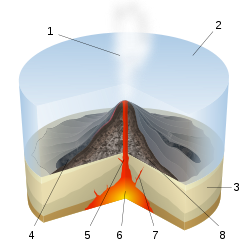Submarine volcano
It has been suggested that this article be merged with Submarine eruption to Submarine volcanos and eruptions. (Discuss) Proposed since June 2015. |

1. Water vapor cloud
2. Water
3. Stratum
4. Lava flow
5. Magma conduit
6. Magma chamber
7. Dike
8. Pillow lava

Submarine volcanoes are underwater vents or fissures in the Earth's surface from which magma can erupt. A large number of submarine volcanoes are located near areas of tectonic plate movement, known as mid-ocean ridges. The volcanoes at mid-ocean ridges alone are estimated to account for 75% of the magma output on Earth.[1] Although most submarine volcanoes are located in the depths of seas and oceans, some also exist in shallow water, and these can discharge material into the atmosphere during an eruption. The total number of submarine volcanoes is estimated to be over 1 million, of which some 75 000 rise more than 1 km above the seabed.[1]
Hydrothermal vents, sites of abundant biological activity, are commonly found near submarine volcanoes.
Effect of water on volcanoes
The presence of water can greatly alter the characteristics of a volcanic eruption and the explosions of underwater volcanoes in comparison to those on land.
For instance, water causes magma to cool and solidify much more quickly than in a terrestrial eruption, often turning it into a volcanic glass. The lava formed by submarine volcanoes is quite different from terrestrial lava. Upon contact with water, a solid crust forms around the lava. Advancing lava flows into this crust, forming what is known as pillow lava.
Below ocean depths of about 2200 m, where the pressure exceeds the critical pressure of water (22.06 MPa or about 218 atmospheres), it can no longer boil; it becomes a supercritical fluid. Without boiling sounds, deep-sea volcanoes can be difficult to detect at great distances using hydrophones.
Topographical activity
Scientists still have much to learn about the location and activity of underwater volcanoes. The Kolumbo underwater volcano in the Aegean Sea was discovered in 1650 when it burst from the sea and erupted, killing 70 people on the nearby island of Santorini. More recently, NOAA's Office of Ocean Exploration has funded exploration of submarine volcanoes, with the Ring of Fire missions to the Mariana Arc in the Pacific Ocean being particularly noteworthy. Using Remote Operated Vehicles, scientists studied underwater eruptions, ponds of molten sulfur, black smoker chimneys and even marine life adapted to this deep, hot environment.
Many submarine volcanoes are seamounts, typically extinct volcanoes that rise abruptly from a seafloor of 1,000 - 4,000 meters depth. They are defined by oceanographers as independent features that rise to at least 1,000 meters above the seafloor. The peaks are often found hundreds to thousands of meters below the surface, and are therefore considered to be within the deep sea.[2] An estimated 30,000 seamounts occur across the globe, with only a few having been studied. However, some seamounts are also unusual. For example, while the summits of seamounts are normally hundreds of meters below sea level, the Bowie Seamount in Canada's Pacific waters rises from a depth of about 3,000 meters to within 24 meters of the sea surface.
Identifying types of eruptions by sounds

There are two types of submarine eruptions: One is created by the slow release and bursting of large lava bubbles, and the other one is created by a quick explosion of gas bubbles. Lava can affect marine animals and ecosystems differently than gas can, so it is important to be able to distinguish the two.
Scientists have been able to connect sounds to sights. in both types of eruptions. In 2009, a video camera and a hydrophone were floating 1,200 meters below sea level in the Pacific Ocean near Samoa, watching and listening as the West Mata Volcano erupted in several ways. Putting video and audio together let researchers learn the sounds made by slow lava bursting and the different noises made by hundreds of gas bubbles.[4][5]
See also
References
- ^ a b Martin R. Speight, Peter A. Henderson, "Marine Ecology: Concepts and Applications", John Wiley & Sons, 2013. ISBN 978-1-4051-2699-1.
- ^ Nybakken, James W. and Bertness, Mark D., 2005. Marine Biology: An Ecological Approach. Sixth Edition. Benjamin Cummings, San Francisco
- ^ "Scientists Discover and Image Explosive Deep-Ocean Volcano". NOAA. 2009-12-17. Retrieved 2009-12-19.
- ^ Scientificamerican.com 2015-04-22 Undersea Volcano Explodes as Scientists Watch
- ^ Dziak, R. P.; Bohnenstiehl, D. R.; Baker, E. T; Matsumoto, H.; Caplan-Auerbach, J.; Embley, R. W.; Merle, S. G.; Walker, S. L.; Lau, T.-K.; Chadwick, W. W. (2015). "Long-term explosive degassing and debris flow activity at West Mata submarine volcano". Geophysical Research Letters. 42 (5): 1480–1487. doi:10.1002/2014GL062603.
External links
- Volcano Information from the Deep Ocean Exploration Institute, Woods Hole Oceanographic Institution
- Volcano World - now maintained by the Department of Geosciences at Oregon State University
- Britannica - Submarine Volcanoes
- United States Geological Survey
- Ring of Fire Exploration Mission

